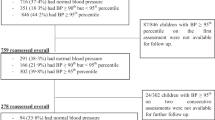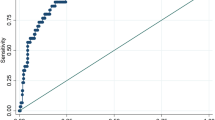Abstract
The aim of the study was to examine the association of a trend in body mass index (BMI) status with current blood pressure in a cohort of school children from South India. A population of 25 228 children was selected using stratified random sampling method. Height and weight were measured in 2003–2004. Height, weight and blood pressure were measured in 2005–2006. A total of 12 129 children aged 5–16 years having paired data were analysed. Blood pressure and BMI values were converted to Z scores using International paediatric reference values. An increase in Z BMI meant that the child is moving to a higher BMI level with respect to his or her age and sex. In the cohort, 62.4% children had a higher Z BMI at follow-up than at baseline. Children with higher Z BMI at follow-up were labelled as positive BMI status group (PBSG) and the remaining as negative BMI status group (NBSG). The positive trend in BMI was more in rural areas, government schools and girls. In all subgroups, PBSG showed significantly higher systolic blood pressures (SBPs) than NBSG. PBSG showed significantly higher diastolic blood pressures (DBPs) in urban area, government schools and girls when compared with NBSG. Prevalence of first instance systolic hypertension was more in PBSG in all the subgroups except in rural children. Prevalence of diastolic hypertension was significantly higher in PBSG in urban subgroup only. BMI status trends are associated with blood pressure distribution in children.
This is a preview of subscription content, access via your institution
Access options
Subscribe to this journal
Receive 12 digital issues and online access to articles
$119.00 per year
only $9.92 per issue
Buy this article
- Purchase on Springer Link
- Instant access to full article PDF
Prices may be subject to local taxes which are calculated during checkout


Similar content being viewed by others
References
Wang Y, Lobstein T . Worldwide trends in childhood overweight and obesity. Int J Pediatr Obes 2006; 1: 11–25.
Ji CY, Sun JL, Chen TJ . Dynamic analysis on the prevalence of obesity and overweight school-age children and adolescents in recent 15 years in China. Zhonghua Liu Xing Bing Xue Za Zhi 2004; 25: 103–108.
Raj M, Sundaram KR, Paul M, Deepa AS, Kumar RK . Obesity in Indian children: time trends and relationship with hypertension. Natl Med J India 2007; 20: 288–293.
Singh AS, Mulder C, Twisk JW, van Mechelen W, Chinapaw MJ . Tracking of childhood overweight into adulthood: a systematic review of the literature. Obes Rev 2008; 9: 474–488.
Poirier P, Giles TD, Bray GA, Hong Y, Stern JS, Pi-Sunyer FX et al. Obesity and cardiovascular disease: pathophysiology, evaluation, and effect of weight loss: an update of the 1997 American Heart Association Scientific Statement on Obesity and Heart Disease from the Obesity Committee of the Council on Nutrition, Physical Activity, and Metabolism. Circulation 2006; 113: 898–918.
Botton J, Heude B, Kettaneh A, Borys JM, Lommez A, Bresson JL et al. Cardiovascular risk factor levels and their relationships with overweight and fat distribution in children: the Fleurbaix Laventie Ville Santé II study. Metabolism 2007; 56: 614–622.
Rosner B, Prineas R, Daniels SR, Loggie J . Blood pressure differences between blacks and whites in relation to body size among US children and adolescents. Am J Epidemiol 2000; 151: 1007–1019.
Freedman DS, Dietz WH, Srinivasan SR, Berenson GS . The relation of overweight to cardiovascular risk factors among children and adolescents: the Bogalusa Heart Study. Pediatrics 1999; 103 (6 Pt 1): 1175–1182.
Sorof JM, Poffenbarger T, Franco K, Bernard L, Portman RJ . Isolated systolic hypertension, obesity, and hyperkinetic hemodynamic states in children. J Pediatr 2002; 140: 660–666.
Luepker RV, Jacobs DR, Prineas RJ, Sinaiko AR . Secular trends of blood pressure and body size in a multi-ethnic adolescent population: 1986 to 1996. J Pediatr 1999; 134: 668–674.
Li L, Law C, Power C . Body mass index throughout the life-course and blood pressure in mid-adult life: a birth cohort study. J Hypertens 2007; 25: 1215–1223.
He Q, Ding ZY, Fong DY, Karlberg J . Blood pressure is associated with body mass index in both normal and obese children. Hypertension 2000; 36: 165–170.
Dunton GF, Kaplan J, Wolch J, Jerrett M, Reynolds KD . Physical environmental correlates of childhood obesity: a systematic review. Obes Rev 2009; 10: 393–402.
Shetty PS . Nutrition transition in India. Public Health Nutr 2002; 5 (1A): 175–182.
National High Blood Pressure Education Program Working Group on High Blood Pressure in Children and Adolescents. The fourth report on the diagnosis, evaluation, and treatment of high blood pressure in children and adolescents. Pediatrics 2004; 114: 555–576.
Department of Health and Human Services. Centers for Disease control and Prevention, USA. CDC growth charts for the United States (database on the internet}. Available at http://www.cdc.gov/nchs/data/nhanes/growthcharts/zscore/bmiagerev.xls (Accessed 12 January 2007).
Wang TY, Liang L, Mi J, Wang L, Zhang MM, Hou DQ et al. Blood pressure of children and adolescents in Beijing. Zhonghua Er Ke Za Zhi 2007; 45: 378–381.
Lawlor D A, Smith G D . Early life determinants of adult blood pressure. Curr Opin Nephrol Hypertens 2005; 14: 259–264.
Kivimäki M, Lawlor DA, Smith GD, Keltikangas-Järvinen L, Elovainio M, Vahtera J et al. Early socioeconomic position and blood pressure in childhood and adulthood: the Cardiovascular Risk in Young Finns Study. Hypertension 2006; 47: 39–44.
Kolacek S, Kapetanoviæ T, Luzar V . Early determinants of cardiovascular risk factors in adults. B. Blood pressure. Acta Paediatr 1993; 82: 377–382.
Whincup P, Cook D, Papacosta O, Walker M . Birth weight and blood pressure: cross sectional and longitudinal relations in childhood. BMJ 1995; 311: 773–776.
Raj M, Sundaram KR, Paul M, Kumar RK . Blood pressure distribution in children. Indian Pediatr, e-pub ahead of print 3 September 2009; pii: S097475590800123-1.
Acknowledgements
This study was fully supported by a grant from the Indian Council of Medical Research.
Author information
Authors and Affiliations
Corresponding author
Rights and permissions
About this article
Cite this article
Raj, M., Sundaram, K., Paul, M. et al. Body mass index trend and its association with blood pressure distribution in children. J Hum Hypertens 24, 652–658 (2010). https://doi.org/10.1038/jhh.2010.6
Received:
Revised:
Accepted:
Published:
Issue Date:
DOI: https://doi.org/10.1038/jhh.2010.6
Keywords
This article is cited by
-
Environments affect blood pressure in toddlers: The Japan Environment and Children’s Study
Pediatric Research (2024)
-
Cardiovascular risk in nonobese hypertensive adolescents: a study based on plasma biomarkers and ultrasonographic assessment of early atherosclerosis
Journal of Human Hypertension (2013)
-
Hypertension in Children and Adolescents: Epidemiology and Pathogenesis
The Indian Journal of Pediatrics (2013)



